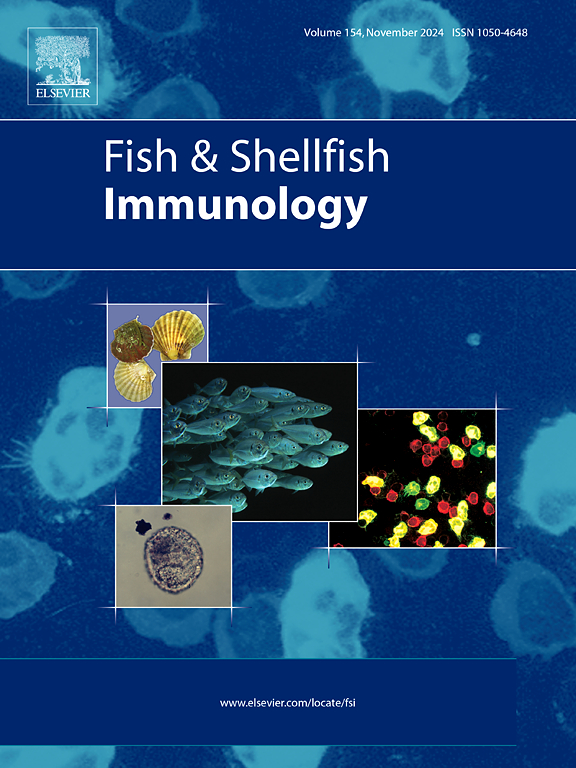SHP-1负调控脂多糖诱导的半舌鳎原代巨噬细胞M1极化、吞噬活性、炎症和氧化应激
IF 4.1
2区 农林科学
Q1 FISHERIES
引用次数: 0
摘要
巨噬细胞是硬骨鱼抗菌免疫的主要效应细胞,参与先天免疫和适应性免疫反应。然而,多功能蛋白酪氨酸磷酸酶SHP-1在硬骨鱼巨噬细胞中的具体作用尚不清楚。本研究首先利用革兰氏阴性菌的主要致病成分脂多糖(LPS)建立细胞免疫模型,全面阐明了SHP-1在中国舌鳎原代巨噬细胞中的功能。结果表明,过表达SHP-1可抑制原代巨噬细胞M1极化、吞噬、呼吸爆发,抑制活性氧(ROS)、丙二醛(MDA)和促炎细胞因子(il-1β、il-6)的产生,增加超氧化物歧化酶(SOD)和抗炎细胞因子(il-10)的表达。而SHP-1沉默(通过siRNA或抑制剂)则发挥了完全相反的作用,进一步强调了其作为负调节因子的作用。更深入地,我们发现SHP-1抑制TLR5-MYD88-NFκB和JAK-STAT3信号通路的激活/转导,从而减轻中国舌鳎巨噬细胞的过度免疫反应。总之,我们的研究结果系统地描述了SHP-1的功能,并为氧化应激/炎症相关疾病的管理提供了机制见解,这将有助于水产养殖的可持续发展。本文章由计算机程序翻译,如有差异,请以英文原文为准。
SHP-1 negatively regulates LPS-induced M1 polarization, phagocytic activity, inflammation and oxidative stress in primary macrophages of Chinese tongue sole (Cynoglossus semilaevis)
Macrophages serve as the primary effector cells in antibacterial immunity in teleost, engaging in both innate and adaptive immune response. However, the specific role of SHP-1, a multi-functional protein tyrosine phosphatase, in teleost macrophages remains elusive. In this study, we first established a cellular immune model using lipopolysaccharide (LPS), a major pathogenic component of Gram-negative bacteria, and then we comprehensively elucidated the function of SHP-1 in primary macrophages derived from Chinese tongue sole. Our results demonstrated that overexpression of SHP-1 inhibited M1 polarization, phagocytosis, respiratory burst of primary macrophages, suppressing the generation of excessive reactive oxygen species (ROS), malondialdehyde (MDA), and proinflammatory cytokines (il-1β, il-6), but increasing the expression of superoxide dismutase (SOD) and anti-inflammatory cytokine (il-10). Whereas SHP-1 silencing (through siRNA or inhibitor) exerted completely opposite effects, further emphasizing its roles as a negative regulator. More in-depth, we revealed that SHP-1 suppressed the activation/transduction of the TLR5-MYD88-NFκB and JAK-STAT3 signal pathways, thereby mitigating the excessive immune reaction in macrophages of Chinese tongue sole. In summary, our findings systematically delineate the functions of SHP-1 and offer mechanistic insights into the management of oxidative stress/inflammation-related diseases, which will contribute to the sustainable development of aquaculture.
求助全文
通过发布文献求助,成功后即可免费获取论文全文。
去求助
来源期刊

Fish & shellfish immunology
农林科学-海洋与淡水生物学
CiteScore
7.50
自引率
19.10%
发文量
750
审稿时长
68 days
期刊介绍:
Fish and Shellfish Immunology rapidly publishes high-quality, peer-refereed contributions in the expanding fields of fish and shellfish immunology. It presents studies on the basic mechanisms of both the specific and non-specific defense systems, the cells, tissues, and humoral factors involved, their dependence on environmental and intrinsic factors, response to pathogens, response to vaccination, and applied studies on the development of specific vaccines for use in the aquaculture industry.
 求助内容:
求助内容: 应助结果提醒方式:
应助结果提醒方式:


